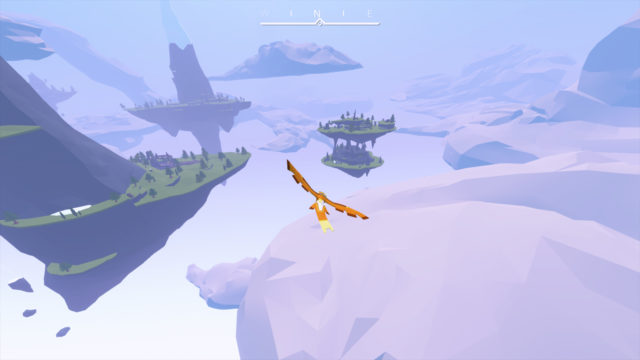Cohesive music and visuals make for a beautiful experience; interesting world with compelling lore; flying around is just plain fun
Some technical issues including noticeable drops in framerate and a few more potentially serious problems; short and maybe a little too simple for some
Narrative-driven games based around exploration are quite common now, as many gamers have indicated their desire to occasionally have a leisurely stroll through an interesting digital world. Some have derisively labelled these sorts of games as “walking simulators” but Aer: Memories of Old dodges that label in a simple yet interesting way: it takes to the air.
In Aer, you assume the role of a young girl with the ability to transform into a bird as she retraces the steps of a famous priestess who once set about on a pilgrimage that had her visiting every culture and communing with the various gods governing the land following a massive catastrophe that saw the land literally torn to pieces. However, your journey is all the more urgent as the world is all but dead, having grown even worse since the priestess’ time. Thus, you too must visit the nations of the world long separated by gulfs of sky and ask the gods if anything can be done to save the world.
Considering it’s the thing you are trying the save, it only makes sense that the world is the real focus of Aer. While the main quest reveals the thrust of the central plot, much of your understanding of the setting comes through simple exploration. While you soar from one floating island to the next searching for your next objective, many interesting landmarks will catch your eye and most reward closer examination with new details, both stated and implied. Ancient scrolls spell events out in clear exposition, while the lingering ghosts of past people and events reveal how the now dead civilizations reacted to their dying world; some took it in stride, others fled for hopes of finding a better home, and others devolved into war. Still, the ancient priestess and her journey remains a constant presence, no matter where you go.

Following this main thread leads you to the most “gamey” aspects of Aer, and it plays out in a somewhat Zelda sort of way. You come across a number of, for lack of a better word, dungeons that grant key items needed to access future dungeons and ultimately reach the end of the story. Since the game is combat free, these areas focus on fairly simple puzzles, almost entirely based on flipping switches, and simple platforming. Within these areas, you can’t assume your bird form, so you are left with your basic jumping, which is serviceable but still a little on the floaty side. However, nothing is especially challenging or even all that long as these areas generally go by very quickly due to smart pacing and level design.
The variety provided by these dungeons is appreciated, but so is their brevity, because the real joy of Aer really is rooted in its flying. Leaping in the air and free falling hundreds of feet before transforming into a bird is exhilarating entirely thanks to great mechanical design. You can’t really fail or die, so the sense of fun comes through the feel as you flap your wings to gain speed and altitude and then dive or soar to your heart’s content. Crashing into something reverts you back to your human form, but you can just as easily turn back to a bird with another button press. The fun of flying combined with the lore gleaned through exploration really makes the act of exploration worthwhile all by itself.
The look and sound of the game also help drive this urge to uncover every corner of the world. Technically speaking, there isn’t anything all that impressive happening on screen as everything is made from surprisingly few polygons and textures are incredibly flat. However, the art direction and vivid colors still manage to make everything look interesting and compelling. The soundtrack serves a similar purpose and is smartly designed both around the aesthetic and the gameplay. Songs are generally very atmospheric, focusing on the feel of each area rather than creating memorable melodies, however the way in which music changes based on what form your character is in is especially noteworthy. As you fly, the music is much more active with a faster pace and pluckier instrumentation, but when you’re on the ground, the music seamlessly transitions to a slower, more relaxed version of the same music. Altogether, it creates a very cohesive and rewarding experience.

Unfortunately, the game doesn’t entirely pull through from a technical perspective. First, and most noticeable is the framerate which does skip around quite a bit, especially when you’re moving the camera around while flying, which is something you do quite often. This isn’t a big problem given the lack of threats or any real fail state, but it does disrupt the immersion and great sense of flow the flying generally has. Beyond that, I did experience a few other issues that might not affect everyone. First, I had the game freeze on a load screen, which did take a while to notice given that load times are fairly long. The second was maybe a bit more peculiar. The A button is used not only for jumping and transforming, but also talking to other characters, and at one point I had the prompt to talk not go away, even when I moved far away from any other characters; this meant every time I tried to jump I just initiated the conversation. Rebooting the game fixed this issue, but it was still quite annoying when it occurred.
Aside from these technical issues, the only major problems that might hinder a player’s enjoyment are more or less rooted in the type of game it is. There are a few moments where combat or more direct involvement in certain climactic events would have added something, and the overall time it takes to play through the story and thoroughly explore the world is rather short, likely just about two to four hours depending on how much aimless flying you feel like doing.
But if these issues don’t sound like too much of a concern, then Aer: Memories of Old is fairly easy to recommend. Overall, the game is just an exceptionally pleasant experience. Nothing it does is truly groundbreaking but almost everything just gels together into a very cohesive experience both aesthetically and in terms of gameplay. It’s an exploration game that has both a world you’ll want to see coupled with a means of traversing the world that’s just plain fun. What more can you ask for in such a game?
Nintendojo was provided a copy of this game for review by a third party, though that does not affect our recommendation. For every review, Nintendojo uses a standard criteria.




 ShareThis
ShareThis





